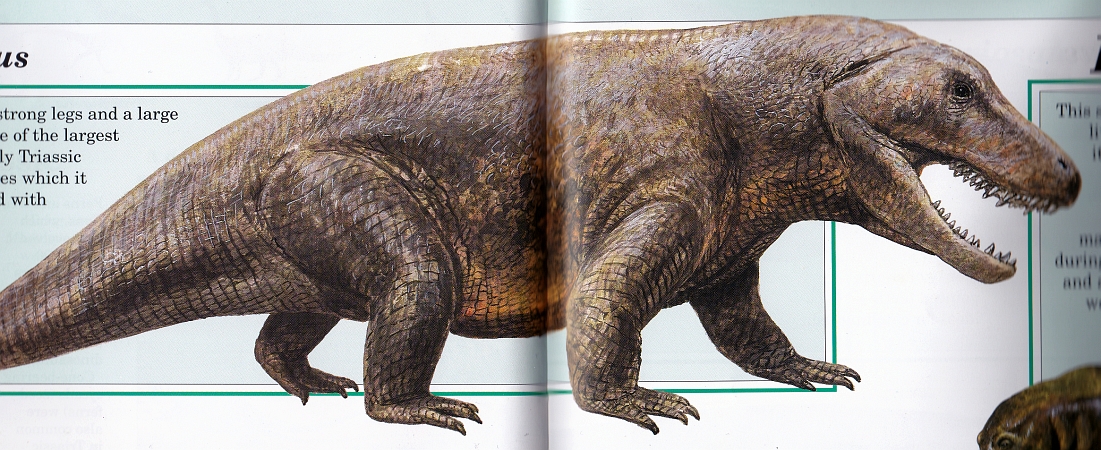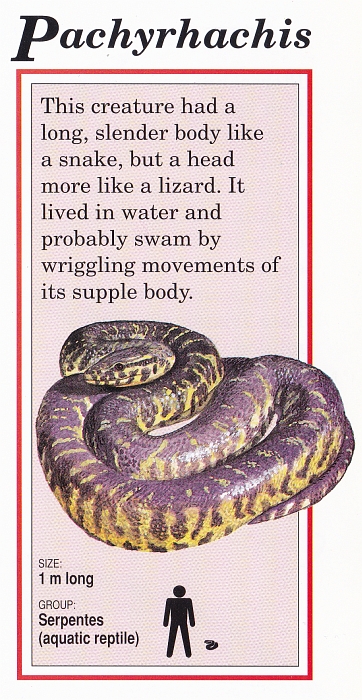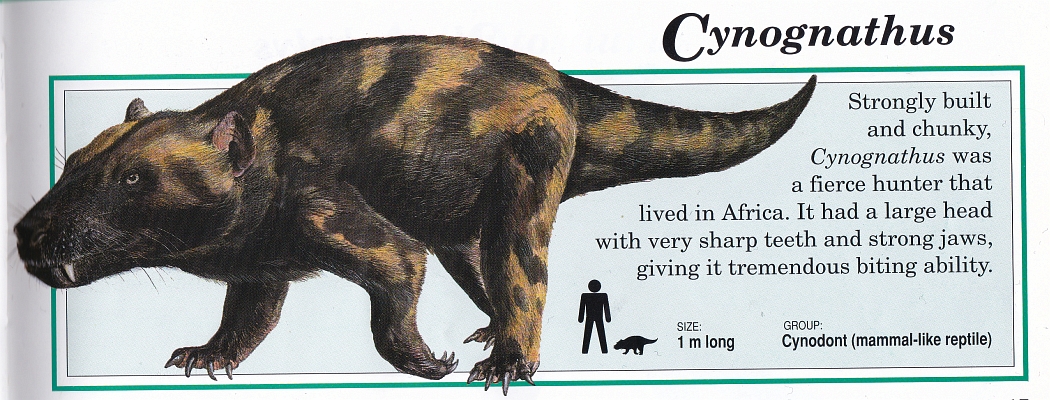Because the last post got a least a couple of comments asking for it, let’s take this Steve Kirk-illustrated children’s book out for one more spin. Naturally, and in spite of its name, the Dinosaur Encyclopaedia for Children contains a rather large variety of non-dinosaurs – larger, in fact, than in many other books that are ostensibly about dinosaurs but veer off into the realm of otherprehistoricanimals. These include all manner of pterosaurs, crocodilians, squamates, synapsids and various marine reptiles – including this blimp.

Now, I should point out that, by the standards of the time, this is rather a good reconstruction. In fact, Kirk maintains a very high standard for his marine reptiles, which is both surprising and very welcome. (With the caveat that much of my knowledge is based on what I half-remember Adam Smith telling me about a decade ago.) Still, it’s amusing from our modern-day perspective to see these reconstructions of Shonisaurus as a parade balloon – I have a particular fondness for the old Schleich toy, which I found on sale second-hand for a pound. Kirk’s illustration is as superbly painted and shaded as ever, and I like the subtle, spotty camouflage pattern. Its scale diagram even manages to make kaiju-Tarbosaurus look small.

Kirk’s Liopleurodon is rather pleasing too, especially as it lacks the tired Walking With Dinosaurs blue-and-white colour scheme. Of course, it is several years older, but I’d like to think Kirk wouldn’t have done that anyway. Instead, it’s a stripy brown which, for all my complaints about the dull browns and greens of the dinosaurs in my previous post, actually rather suits this beast – it looks menacing, in an understated sort of way. You’ll note that the scale diagram would have you believe in a 12-metre Liopleurodon, which would be considered something of an overestimate today, but is certainly nowhere near as absurdly huge as the one depicted in said TV show.
And hey, Metriorhynchus is here to, also looking rather natty with its stripy scales. Is it just me, or do we not see so much of Metriorhynchus in popular books these days? Crowded out by younger, trendier marine reptiles, no doubt. Perhaps a moderate snout isn’t considered exciting enough these days. I have fond memories of its name being slotted into a song about marine reptiles that featured on an Early Learning Centre cassette I owned as a child. Also, I’m sure I’ve seen it in a few museums or something, probably. Wait, what are we talking about again?

Now, a fair number of pterosaurs appear in this book, including what would be considered fairly obscure genera outside of specialist pterosaur-tomes. Unfortunately, I appear to have been very drawn to this Pteranodon, a pterosaur so commonplace that you wouldn’t look twice if one accosted you for your fish and chips at the seaside. I’m sorry, but I really like the black look, and that nifty contrasting crest simply seals the deal. This is a very handsome Pteranodon, I’ll have you know – it’s even suitably hairy.

This Quetzalcoatlus has, it’s fair to say, aged rather less well. Still, the evolution of this pterosaur in art – from the time of its discovery, through a long period when it was poorly understood, and to the endless Witton rip-offs of more recent years – is endlessly fascinating. So, here it is. Super-long-beaked Terrestrial Stalker, this ain’t – it looks like it’s borrowed the head from a marabou stork. Still, it’s better this than one of those pin-headed toothy nightmare monsters that haunted earlier books. It’s interesting to note the complete absence of a crest, or even a head nubbin; I thought the latter had become more-or-less standard by this time, but that may simply be indicative of the number of artists who were copying John Sibbick.

Now here’s an animal that one certainly doesn’t tend to see in kids’ books – the large Early Triassic archosaur Erythrosuchus. Rather like the later rauisuchids, its skull resembles that of a theropod dinosaur (at least superficially), which instantly makes it look very cool; its lack of appearances in popular media can probably be put down to it living before dinosaurs, but after Dimetrodon (a time known as the Awkward Triassic Pop-Palaeo Gap, or the Popgappian age). At least this impressive-looking beast is able to luxuriate over two pages here, and Kirk does a reliably fine job of illustrating it.

I was also very impressed that a book with such a perfunctory title – a title that doesn’t even mention otherprehistoricanimals! – made room for Pachyrhachis, a snake with wee limbs from the Late Cretaceous. Kirk’s illustration is very vibrant and quite beautiful, and shows how much careful attention he paid to animals that he would have been forgiven for bashing out without much thought (given that they’re far from the main attraction here).

Just as lovely is this Cynognathus, which I simply had to include for being so visually striking – there’s just something so convincing and naturalistic about it, in contrast with other reconstructions that make it look rather monstrous. It’s possibly a bit too mammalian – I’m not sure everyone would support those fleshy ears (although I’m certainly no authority on the matter) – but it nevertheless looks like a realistically fleshed-out creature, with beautifully stripy fur and a telling look in its eye, rather than screaming “PALAEO-RECONSTRUCTION”. I like it.

And finally – another cynodont, and another fine illustration. I love the red-brown stripes on the body and the horizontal pupil, which rather reminds me of a dwarf mongoose. That may not be intentional (the two animals have virtually nothing in common), but it’s an intriguing little detail all the same. You’ll note that, in 1992, we were still very much in “mammal-like reptile” territory when it came to popular books – mammals were still inevitably described as “evolving from reptiles” in all the books I read as a kid. Of course, we don’t subscribe to such nonsense these days, because phylogenetics has swept away all before it, whether a few cranks like it or not. Stem-mammals weren’t reptiles, birds ARE dinosaurs, and pterosaurs ARE stem-birds, or something. Hurrah!
I do hope you’ve enjoyed this tour of fine 1990s Kirkwork, in three parts. Coming up next from me is some delightfully generic 1970s book I found on eBay. See you then!







5 Comments
Jamale Ijouiher
October 13, 2020 at 11:12 amI honestly wonder if this Pteranodon influenced the design team on Jurassic Park 3; since the resemblance between the two colour-schemes is uncanny. https://vignette.wikia.nocookie.net/jpl-live-the-legend/images/1/10/Dc_card_ptera3_big.jpg/revision/latest?cb=20130120090546
Timur Sivgin
October 13, 2020 at 1:38 pmI have seen that exact same Cynognathus (maybe with the colour changed a bit) in a German dinosaur book I owned as a child that was different from this one. I wonder if they copied Kirk or both of them based it off another source.
Chocoviv
October 13, 2020 at 10:32 pmBeautiful art!
Grant Harding
October 14, 2020 at 10:45 amI had that Early Learning Centre cassette as well!
Mike Taylor
November 11, 2020 at 1:29 pm“I have fond memories of its name being slotted into a song about marine reptiles that featured on an Early Learning Centre cassette I owned as a child.”
Dinosaurs, dinosaurs
Lived for more than a hundred million years
And then they disappeared!
We sing that song ALL the time in our family!